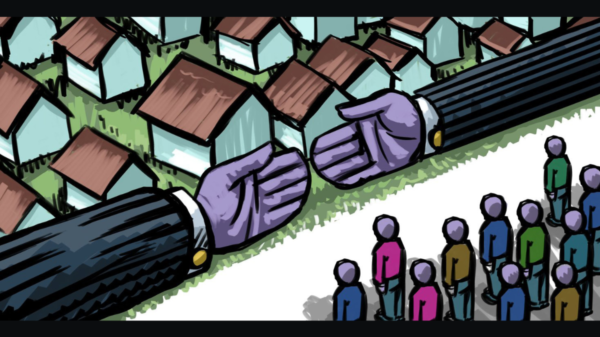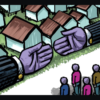By Jim Parrott and Mark Zandi
From – https://www.phillytrib.com/
Reprinted – by Texas Metro News

The nation’s economy is doing remarkably well. Inflation is coming down, unemployment remains low and growth is robust. One glaring exception, however, is housing.
According to the National Association of Realtors, it is more difficult for first-time buyers to purchase a home than at any time in two generations, short-circuiting the path to homeownership for millions, bogging down the housing market and hampering the nation’s economic growth.
While the ditch that we find ourselves in is deep, Congress could get us out by improving the economics of building entry-level housing and putting more aspiring homeowners in a position to take advantage of it.
When the pandemic hit, the median price for a starter home was about $234,000. Today, one would have to pay nearly $350,000 for roughly the same house, coming up with at least $11,000 more for a down payment and about $1,000 more a month in mortgage payments. And that’s if they can find a house to buy. There are fewer houses on the market that at any time on record.
As with other strains in the market today, one can place some of the blame on the rise in interest rates. Not only has that made mortgages much more expensive, it’s exacerbated the long-standing shortage in housing supply, particularly at the lower-priced part of the market.
The economics for building entry-level homes were already challenging in a low-rate environment, but with construction financing now in the high single digits, they have become all but impossible for many builders. And those expanding families finally ready to trade up from their entry-level home, freeing up a spot for another family to buy their first home? They’re waiting, reluctant to trade in their 3.5% mortgage for a 7% mortgage. The market machinery that cranks out housing supply at the bottom of the market has effectively ground to a halt.
Frustration is running high. Housing is the hardest-to-handle expense for many of those in their prime home-buying years, with fewer viewing it as a good time to buy a home that at any time on record.
Many view the purchase of a first home in charged terms, as an anchor in a good community, a vehicle to build wealth and often a rite of passage into the middle class. Finding it drifting out of reach often taps deeper feelings of economic insecurity and frustration.
Conditions will improve when rates begin to come down, lowering the cost of a mortgage and freeing up inventory as those anxious to find more suitable housing finally put theirs on the market. But falling rates will not solve the underlying structural problems that caused the housing shortfall in the first place. Once rates normalize, housing affordability will simply return to where we were prior to the pandemic, going from dismal to just bad.
Unless, of course, lawmakers do something about it.
Despite the years of inaction, it’s not that complicated. The math for building housing at the bottom of the market simply isn’t profitable, and it still won’t pencil out once rates normalize. We need to change the math.
The most straightforward way to do this would be by providing tax relief for builders who build homes sold to first-time homebuyers at or below the area’s median home price.
Congress can do this by reducing the federal income taxes that builders pay on these sales, or by expanding the scope of the popular Low-Income Housing Tax Credit program, the longstanding and remarkably effective program that provides tax credits for builders who build affordable rental housing.
We estimate that using either to eliminate the tax impact for these sales could lead to more than 1 million new entry-level homes in the US over the next decade and a meaningful softening of home prices at the bottom of the market.
Lawmakers should complement this support to increase the supply of housing with targeted help for those looking to buy their first home. The most effective way to do this would be to allow renters to set up a tax-free savings account to save for a down payment, much like those set up for college savings under Section 529 of the Internal Revenue Code.
To increase the impact, policymakers should match deposits made by those who would be first-generation homeowners, who are less likely to have family wealth to help them clear this often insurmountable hurdle to homeownership. If participant deposits were capped at $20,000 and the match at $10,000, eligible first-time homebuyers would be in position to make a down payment of nearly 10% for the median-priced starter home.
Taken together, these moves would trigger a dramatic increase in the supply and affordability of entry-level homes and put millions of families into position to take advantage of it.
This would be an aggressive effort, costing as much as roughly $90 billion over the next decade, according to our budget analysis, depending on how aggressive Congress wants to be. To cover part of the cost, Congress should consider a tax on institutional investors that own more than 100 single-family rental properties, dampening their economics for buying up much-needed entry-level housing.
But the depth of the ditch we find ourselves in requires an aggressive push.
The US has done this before. The last time we faced such a daunting environment for homeownership was in the wake of World War II when tight lending and limited housing supply left more than half of the nation out of homeownership.
The nation responded by building highways and infrastructure that unleashed a boom in home construction, and providing government-backed, low down payment lending that allowed millions of families to take advantage of the surge in inventory.
In the two decades after World War II, the country saw an unprecedented surge in homeownership to nearly two-thirds of households, just under where it stands today.
Despite the political dysfunction in Congress, there is some cause for optimism. A bipartisan package to expand affordable rental housing has gained momentum in Congress, offering hope that we might finally begin to address a similar shortfall there. And the case for addressing the shortfall in homes aspiring homeowners can afford to buy is just as strong.
The economic and political cost of allowing the first rung of homeownership to continue its drift beyond the reach of millions of frustrated families will only increase the longer it goes on.
The issue is as important as any economic issue we face and deserves to rise to the top of Congress’ agenda, particularly when only those at the top of its agenda have a chance of passage.
Jim Parrott is a non-resident fellow at the Urban Institute and co-owner of Parrott Ryan Advisors. Mark Zandi is chief economist of Moody’s Analytics. CNN





You must be logged in to post a comment Login